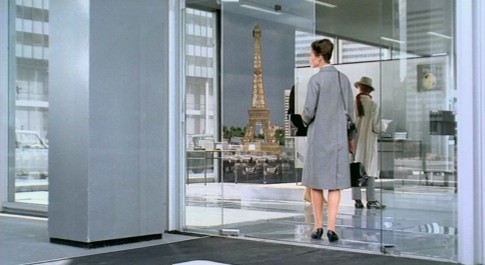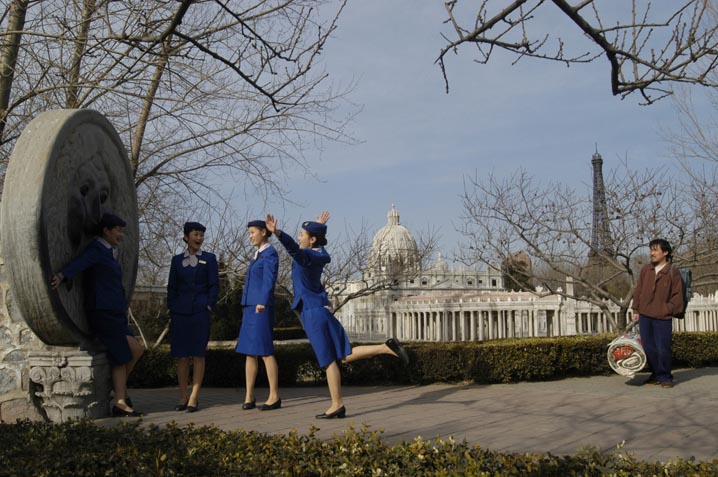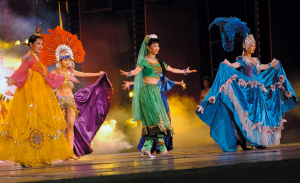This essay started out as a lecture given on the final day of “Urban Trauma and the Metropolitan Imagination,” a conference organized by Scott Bukatman and Pavle Levi and held at Stanford University on May 5-7, 2005. Then it was reprinted in World Cinemas, Transnational Perspectives, edited by Nataša Ďurovičová and Kathleen Newman, New York/London: Routledge, 2009, and it’s appeared in my collection Goodbye Cinema, Hello Cinephilia: Film Culture in Transition (University of Chicago Press, 2010). — J.R.
My subject is the presence or absence of both shared public space and virtual private space in two visionary and globally-minded urban epics made about 37 years apart, on opposite sides of the planet — Jacques Tati’s Playtime (1967) and Jia Zhangke’s The World [Shijie] (2004), coincidentally the fourth commercial feature of each writer-director. Both films can be described as innovative and very modern attacks on modernity, and both have powerful metaphysical dimensions that limit their scope somewhat as narrative fictions. I should add that they both project powerful yet deceptive visions of internationalism that are predicated both literally and figuratively on trompes d’oeil, specifically on tricks with perspective and the uses of miniaturized simulacra. (I’m referring here to both emblematic sites, such as the Eiffel Tower in both films, and the scaled-down skyscrapers used in the set built for Playtime.) In this sense, among others, both films are social critiques about what it means to impose monumental façades on tourists and workers — visitors and employees — who continue to think small.
One significant difference between the roles played by these films in the respective careers of their makers is that Playtime, by far the more utopian and optimistic of the two films, was the first of Tati’s features to fail at the box office, and it wound up bankrupting him, a disaster that I don’t believe he ever fully recovered from. (Furthermore, Tati was pressured to cut the film during its initial Paris run, and although he later said to me and others that he preferred the original and longer version to all the others, this version apparently hasn’t been seen since the 1970s and may no longer exist.) (1)
Although it’s too early to judge the ultimate effect of The World on Jia Zhangke’s career, it’s worth pointing out that it’s the first of his features to get official sanction from the Chinese government and the only one to date to show commercially in theaters (all the others have circulated illegally in pirated versions on video), despite the fact that it is probably more critical of contemporary life and conditions in mainland China than any of his previous features. Another paradox: the film has been shown in China only or at least mainly in a shortened version, although I’ve been told that the cuts haven’t constituted any sort of political censorship and have been made only in order to show the film more times per day during its commercial playdates. So, ironically, the full 139-minute version can be seen in most countries where the film is being shown, but not in China.
I should add that in some ways I’m more interested in the differences between these two very great films than I am in their similarities. Quite apart from the fact that Playtime, set in Paris, was mainly shot on a massive set outside that city, built expressly for the film, and that The World was mainly shot in an already existing theme park in the vicinity of Beijing, the former film depends on a vision of public life that eliminates any sense of private space or private behavior, while the latter — which is often concerned with the vast discrepancies between (a) decrepit, claustrophobic private spaces and alienated private behavior and (b) the enormous and utopian public spaces in a theme park, specifically as seen from the vantage point of the workers in that theme park — never strays very far from that specialized turf. Both films might therefore be regarded as metaphorical as well as metaphysical statements about the modern world that employ public spaces in order to say something about it.
Another key difference between these films and their respective worlds and eras is the presence and uses in The World of mobile phones and text messaging. This seems especially relevant because the utopian vision of shared public space that informs the latter scenes in Playtime — beginning in a new restaurant called the Royal Garden at night, and continuing the next morning in a Drugstore and on the streets of Paris — is made unthinkable by mobile phones, whose use can be said to constitute both a depletion and a form of denial of public space, especially because the people using them tend to ignore the other people in immediate physical proximity to them.
Moreover, the dystopian vision of alienated and alienating public space in The World also posits a single, utopian form of escape that is tied to these phones and expressed by the film’s abrupt shifts into animation. One might say, however, that the same mobile phones providing a mental escape from the public spaces of The World have also obliterated the sense of shared public space that made Tati’s vision of utopia possible. On the other hand, they also express and seemingly establish, if only temporarily, a kind of shared private space that otherwise seems very difficult for the characters in The World to achieve in other circumstances. Indeed, just about the only sustained intimacy that we find in the film, apart from the kind established through text messaging, is the friendship between Tao (Zhao Tao), the heroine, a professional dancer at the park, and an exploited fellow dancer from Russia named Anna (Alla Chtcherbakova). And significantly, these characters don’t speak a word of one another’s language.
I have little doubt that Tati, if he were alive today, could and probably would construct wonderful gags involving the uses of mobile phones. But I don’t think he would be able to envision the public reclaiming community space in a modern city in quite the same way that he imagined this in the 1960s. More specifically, if he were making Playtime today, I suspect he’d most likely be inventing gags that involve mobile phones in the first part, and then would have to find a way of destroying or at least disempowering those phones in order to make way for the utopian creation of a community with a shared communal space in his second part.
Playtime, shot in 65-millimeter, often makes use of multiple and sometimes even conflicting focal points in order to grant the viewer an unusual amount of freedom and creative participation in scanning the screen for narrative details. Virtually the entire film is set over a 24-hour period, following a group of American tourists in Paris from the time they arrive inside Orly airport at the beginning until the time they leave for the airport the next morning. And the overall visual structure, as was described by Tati himself, develops from an urban landscape of straight lines and right angles that gradually becomes curved and then round as the regimentation of both the architecture and various daytime rituals give way to a more relaxed, spontaneous, and festive atmosphere.
Within this world, there is no real hero or central character. Tati’s Monsieur Hulot, who’s just one figure in the crowd, appears at an office building early in the film in order to meet an executive for some unstated reason. They quickly lose sight of one another, and their day becomes a painful series of missed connections, where the architecture itself — in particular the spatial confusions created by reflections in glass panes — seems to conspire in their mutual disorientation. There are also many other male characters who resemble Hulot in terms of their height, weight, and dress, especially from a distance, adding to the executive’s disorientation as well as our own, and thereby illustrating Tati’s own democratic and non-hierarchical theory of comedy in which, as he put it, “the comic effect belongs to everyone.” Most of the film’s second half is set at a brand-new restaurant on its opening night, the aforementioned Royal Garden, where connections between people rather than disconnections predominate. Hulot, who finally runs into the executive on the street at night, purely by chance, also re-encounters an old army buddy now working at the restaurant, who brings him along; the restaurant’s décor gradually comes loose and falls apart, and the people there, including the employees as well as the clientele, take over the place, so that a kind of anarchistic and carnivalesque atmosphere prevails where public space essentially becomes reclaimed and reinvented.
All the main characters in The World are employees working at a theme park that features simulacra of famous sights around the world such as the Taj Mahal, the leaning tower of Pisa, the Parthenon, and even lower Manhattan with the World Trade Center towers still intact. The two main characters are a couple, the aforementioned Tao and Taisheng (Chen Taisheng), a security guard. Both of them, like Jia himself, come from Fenyang, a small rural town in northern China’s Shanxi province where they were already a couple (and where Jia’s three previous features were shot). Tao came to Beijing first, eventually followed by Taisheng, and their relationship now is much more tenuous than it was in Fenyang. Taisheng eventually betrays her with an older woman named Qun (Yi-qun Wang) who works outside the theme park in a sweat shop, making clothes that are precise imitations of brand-name items found in a fashion catalog. She works, in other words, in a business that is equally involved with simulacra.
Given all the grandiose dance numbers and other kinds of performances that we see at the theme park, all of which are based on representing ersatz versions of various foreign nationalities, The World can be regarded in some ways as a backstage musical. It’s also a failed love story in which it’s suggested that the synthetic environment where these characters work plays a role in making serious relationships difficult. Significantly, in Playtime, dance is seen playing a substantial role in bringing people together at the Royal Garden, and while nothing that qualifies as a love story develops, one nevertheless finds a kind of chaste romantic flirtation between a young woman named Barbara (Barbara Denneke) and Hulot — one that is partially thwarted when the mazelike obstructions in a shop prevent Hulot from delivering a going-away present to her before she departs on her bus. Hulot, however, succeeds in getting one of the “false Hulots”, a younger version of himself, to deliver it to her just in time — a very touching illustration of the generosity of Tati’s democratic vision whereby one Hulot can readily be replaced or supplanted by another. (2)
It’s possible that the utopian vision expressed by Tati of a universal urban experience that can be transcended by an international community is no longer plausible in the same fashion — because even if the same technology is shared around the world, the social meaning of that technology can differ enormously from one culture to the next. There are times when I think that people around the globe have more in common today than they’ve ever had before at any other time in history — if only because the globe is being run by the same people and corporations who are doing the same things everywhere. This idea is in fact already anticipated and satirized in Playtime by the posters we see in a travel agency extolling the virtues of various countries around the world. Each of these posters features an identical anonymous skyscraper resembling all of those that we see in Playtime’s version of Paris, where the more celebrated emblems of the past — the Eiffel Tower, Concorde, Sacre Coeur — seem to survive only as reflections on glass panes.
But there are other times when I think more pessimistically that we’re kept further apart than we ever were before — subdivided into separate target audiences, markets, and DVD zones, territorialized into separate classes and cultures — in spite of our common experiences. This suggests that the technology that supposedly links us all together via phones and computers are actually keeping us all further apart, and not only from each other but also, in a sense, from ourselves. In other words, our sense of our own identities, including especially our social identities, becomes fragmented and compartmentalized, with the operations of Internet chatgroups providing a major illustration of this trend.
Perhaps this paradox about so-called “communications” impeding communication has always been the case. But I think the example of mobile phones illustrates such a cultural difference more vividly than any of Tati’s examples, which are mainly related to architecture. Personally, I despise mobile phones when I encounter other people using them on the buses and streets of Chicago, because I experience them as a rejection of myself as a fellow passenger or pedestrian. One used to assume, whenever one saw a person walking down the street speaking loudly to no one in particular, that this person was insane. Today one commonly assumes that this same person is a sane individual speaking to someone else on a phone, but it might also be possible to assume that the implied rejection of one’s immediate surroundings suggests another kind of insanity, based no less on an antisocial form of behavior.
Yet I have to acknowledge that for a young person who lives with her or his family and feels in desperate need of some kind of privacy, a mobile phone may also represent a kind of liberation. And for the characters we encounter in The World whose private spaces are invariably drab and unattractive, even if they spend most of their waking hours in the utopian spaces of a theme park, it seems that the only dreams that can truly belong to them as individuals are the ones that they can transmit on portable phones to one another via instant messaging. Indeed, according to a recent front-page story in the New York Times by Jim Yardley (April 25, 2005), “About 27% of China’s 1.3 billion people own a cellphone, a rate that is far higher in big cities, particularly among the young. Indeed, for upwardly mobile young urbanites, cellphones and the Internet are the primary means of communication.”
I guess I’m a universalist in Tati’s sense insofar as I can view a film such as The World as being about what’s happening in the world right now and not simply about what’s happening in China — just as I can view Playtime as a film about the world in 1967 and not simply about France. In fact, I regard both films as being in advance of their own times, even literally so. Playtime was shot before France had parking meters, but Tati knew they were coming so he included them in his giant set. I don’t know exactly what Jia is predicting about the future of either China or the world, but I think he feels the shock of capitalism more keenly in some ways than many of us currently do in the West, and out of that shock grows a need for a different kind of fantasy. His view is certainly much bleaker, because whereas for Tati utopia was a reinvention of what we already have, Jia sees it, in the shape of a theme park, as an emblem of something we’ve already lost.
Notes
1.I was privileged to work for Tati in Paris as a “script consultant” for a little over a week in early 1973. For more details, as well as some extended material about Playtime, see “Tati’s Democracy” (Film Comment, May-June 1973) and “The Death of Hulot” (Sight and Sound, Spring 1983). An excerpt from the former, introducing an interview with Tati, is reprinted in revised form in my collection Movies as Politics (Berkeley: University of California Press, 1997); the latter is reprinted in my collection Placing Movies: The Practice of Film Criticism, Berkeley: University of California Press, 1995.
2. In his biography of Tati, David Bellos reveals that Tati was in fact romantically involved with Denneke — a German au pair who had worked for neighbors of his — during part of the shooting of Playtime. (See Jacques Tati, London: The Harvill Press, 1999, p. 265.)
— World Cinemas, Transnational Perspectives (AFI Film Reader), edited by Nataša Ďurovičová and Kathleen Newman, New York/London: Routledge, 2009; derived from a lecture given on the final day of “Urban Trauma and the Metropolitan Imagination,” a conference organized by Scott Bukatman and Pavle Levi and held at Stanford University on May 5-7, 2005.

























